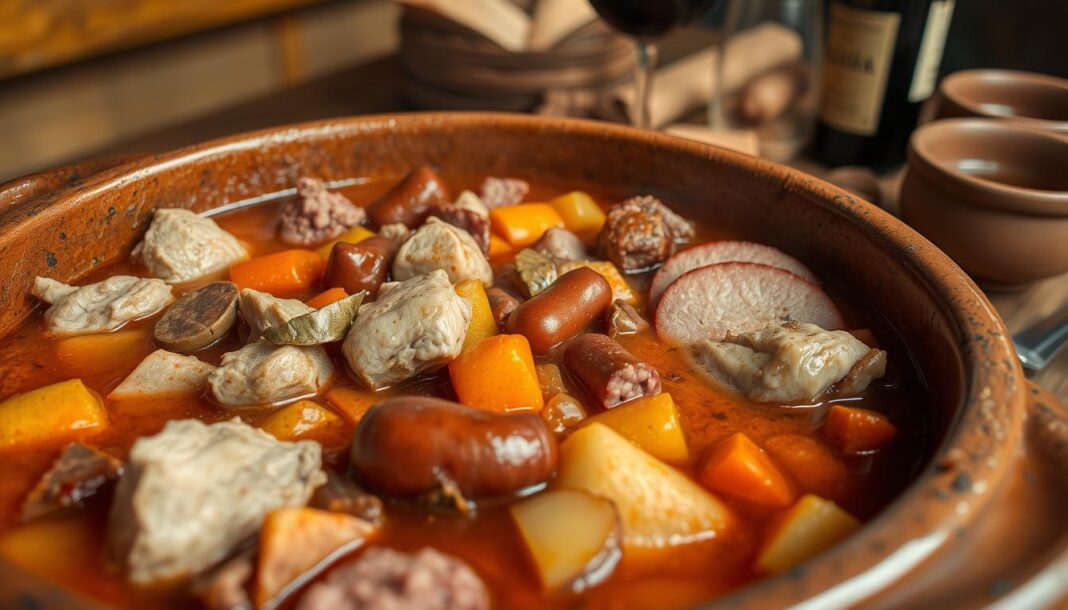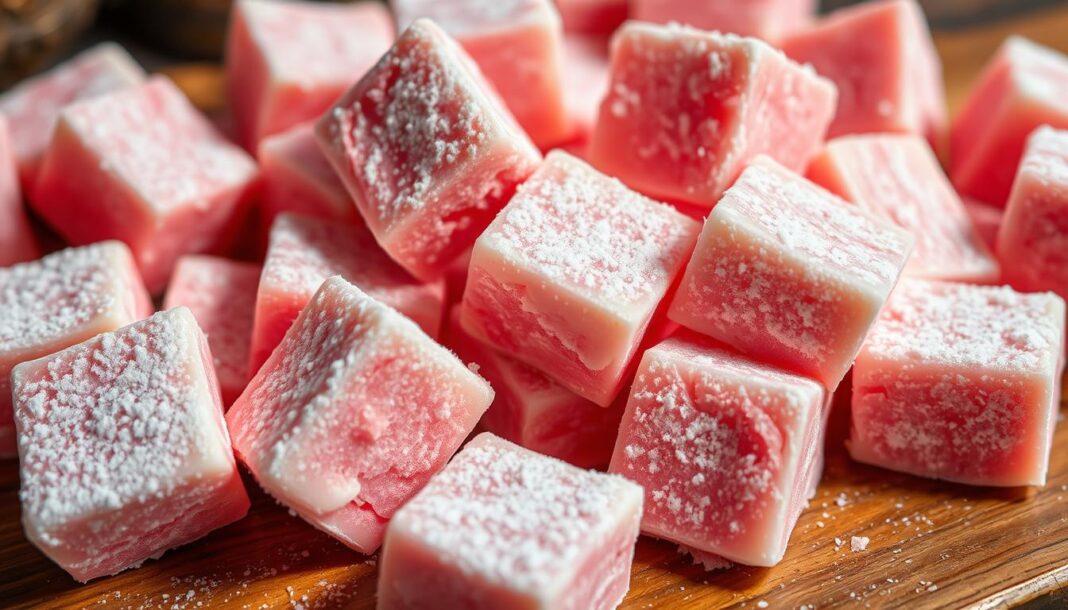Olla podrida, a traditional Spanish stew, has been a cornerstone of Spanish cuisine for centuries. This rich and flavorful dish combines a variety of meats, legumes, and vegetables in a single pot.
The name “olla podrida,” which translates to “rotten pot,” may seem unappetizing, but it actually refers to the rich, slow-cooked flavors of the stew. At its core, olla podrida is a celebration of Spanish comfort food, featuring chickpeas or beans and an assortment of meats and vegetables.
Our comprehensive guide will walk you through the history of this iconic dish and provide a step-by-step recipe to create an authentic olla podrida.
Key Takeaways
- Understanding the history and cultural significance of olla podrida in Spanish cuisine.
- Learning the key ingredients and their roles in the stew.
- Mastering the slow cooking process to achieve rich, melded flavors.
- Discovering variations of olla podrida and its influence on global stew traditions.
- Preparing an authentic olla podrida using our tested method.
The Rich History of Olla Podrida
With its roots deeply embedded in Spanish culinary heritage, olla podrida has a fascinating history that spans centuries. This traditional Spanish stew has been a staple of Spanish cuisine, with its significance extending far beyond the country’s borders.
Origins and Etymology of “Rotten Pot”
The name “olla podrida,” which literally translates to “rotten pot,” is believed to have originated from the term “poderida,” meaning “powerful pot.” This refers to the wealth required to afford the numerous meats traditionally included in the dish. The etymology of olla podrida is as rich as its flavor, with historical references in literary works such as Cervantes’ Don Quixote, where Sancho Panza enthusiastically spots “an olla podrida” bubbling on the fire.
Regional Variations Across Spain
While olla podrida is most strongly associated with the city of Burgos, where it’s traditionally prepared with local red beans, variations exist across Spain. In other regions, chickpeas are used instead, reflecting local preferences and ingredient availability. The dish is presented in different ways, either separating the components or combining everything in one presentation, showcasing the diversity within Spanish cuisine.
Authentic Olla Podrida Recipe
The foundation of a great olla podrida lies in its ingredients, which we’ve carefully selected to ensure an authentic flavor profile. This traditional Spanish stew is known for its rich, complex flavors and hearty ingredients.
Essential Ingredients for Traditional Olla Podrida
The backbone of an authentic olla podrida includes a variety of meats, legumes, and aromatics. The essential ingredients are: pork (1¾ lb fresh, ribs or your preferred cut), chorizo (10 oz), bacon (6 slices), red beans (1 lb dry), and chickpeas (9 oz dry). You’ll also need aromatics like garlic (3 cloves, minced), onion (1 yellow, diced), carrot (1 medium, diced), and leeks (5½ oz, sliced).
The inclusion of pork trotter (1 small) is traditional, as it adds gelatin to the broth, creating a rich, silky texture. Morcilla blood sausages (1-2) can also be added for extra depth of flavor.
The Adobo Marinade: Key to Flavor
The adobo marinade is crucial for developing the complex flavor profile of olla podrida. To prepare the marinade, mix Spanish paprika (¼ cup), dry oregano (3 Tablespoons), minced garlic (2-3 cloves), extra virgin olive oil (5-6 Tablespoons), vinegar (4-5 Tablespoons), and water (3-4 Tablespoons). This marinade transforms the pork components, infusing them with a deep, smoky flavor.
Optional Ingredients and Substitutions
While traditional olla podrida is made with specific ingredients, you can customize the dish to your preferences or dietary needs. For example, you can substitute beef for some of the pork or add different vegetables. Regional variations may include additional meats or alternative seasonings. The key is to maintain the balance of flavors and textures that make olla podrida so beloved.
The traditional relleno dumplings – small egg and breadcrumb balls that absorb the flavorful broth – add a delightful contrast in texture. To make them, mix breadcrumbs (½ cup), beaten eggs (2-3), minced parsley (2 sprigs), and minced garlic (2 cloves), then fry in olive oil until golden.
Step-by-Step Cooking Method
The heart of cooking olla podrida lies in its preparation and cooking technique. To achieve the rich flavors and tender textures characteristic of this traditional Spanish stew, careful attention to detail is crucial.
Preparation: Soaking and Marinating
Proper preparation is key to a successful olla podrida. This involves soaking the beans and marinating the meats.
Bean Preparation
Start by sorting through the beans to remove any debris or stones. Rinse them thoroughly, then cover them with cold water in a large bowl. Let the beans soak overnight, ensuring they are fully submerged. For chickpeas, a similar process is followed, though they may require a slightly longer soaking time. Proper soaking is crucial for achieving the right texture.
Meat Marination Process
To marinate the pork, combine the adobo ingredients in a non-reactive container large enough to hold the pork. Add the pork, including trotters, and rub the marinade into the meat thoroughly. Cover the container and refrigerate overnight. This step allows the flavors to penetrate the meat, enhancing its tenderness and taste.
Cooking the Meats
Place the marinated pork in a large pot or Dutch oven along with bacon and chorizo. Cover the meats with water and bring to a boil. Reduce the heat to a simmer, cover, and cook for about 75 minutes, or until the meat is tender. Remove the meat from the pot and set it aside.
Cooking the Beans and Vegetables
Drain the soaked beans and add them to the meat stock along with onion, carrot, 3 cloves of garlic, and a bay leaf. Add additional water if needed to cover the ingredients by about two inches. Bring to a boil, then reduce the heat to a simmer. Cook, partially covered, for about 1 hour, or until the beans are soft.
Making the Traditional Relleno Dumplings
Meanwhile, combine all the relleno ingredients except oil in a small bowl. Heat about ½ inch of olive oil in a small sauté pan. When hot, drop heaping teaspoons of the breadcrumb mixture into the oil and cook for a couple of minutes on each side. Drain the rellenos on paper towels and set them aside.
About 10 minutes before serving, return the cooked meat to the pot along with the morcilla and rellenos. Simmer for about 10 minutes, until the meat is heated through and the flavors have melded together.
Serving Your Olla Podrida
Serving olla podrida is an art that combines tradition with personal touch. Traditionally, the beans and relleno dumplings are served in bowls, with the meat arranged separately on a platter, accompanied by a glass of Spanish wine. This method, known as “in overturns,” separates the soup, legumes, vegetables, and meat, much like in the traditional Madrid style.
To enhance the dining experience, consider serving crusty bread on the side, along with a simple green salad. For wine pairings, a robust Spanish red wine complements the rich flavors of the stew. Just before serving, a pinch of sweet or spicy paprika can be added to brighten the dish’s flavor profile. Adjusting the salt and pepper to taste is also crucial, respecting the complex flavors developed during the long cooking process.
Allowing the stew to rest briefly before serving is essential, as it lets the flavors settle and integrate. For leftovers, proper storage and reheating methods will maintain the integrity of the components, and interestingly, olla podrida often tastes even better the next day. Whether you’re planning a casual family meal or a formal gathering, olla podrida can be adapted to suit any occasion, making it a versatile and satisfying dish.


